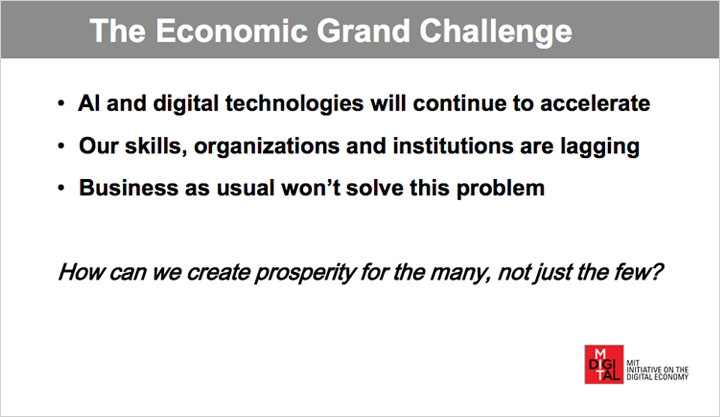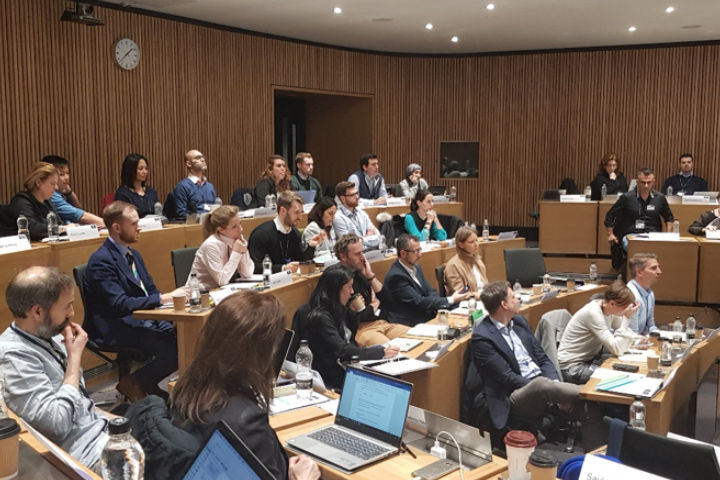June 7th, 2018
The global DISRUPT series of regionally-based meet-ups, comprising their signature 5-minute TED Talks-like presentations, is a unique opportunity for one to articulate an original perspective and to focus on telling as clear, concise and coherent story as possible. LDS’s managing director for Business Strategy and Design, Brad Ivie, was honored with the opportunity to speak at the May 2018 edition of Northern New Jersey’s DISRUPT franchise on “The Key to Digital Transformation: Focus on the Work”. “This was no slam dunk”, Mr. Ivie explained. “The highly-structured format is very challenging, so there is no room for verbal missteps. On top of that, the quality of the other speakers attending was outstanding. It was an honor to speak alongside such a distinguished and insightful group.”
May 29th, 2018
We recently attended the Future of Work conference in New York City hosted by MIT Sloan and its Initiative of Digital Economy (IDE). The event explored the impact of digital progress – especially advancements in general-purpose technologies like AI and machine learning – on traditional jobs, industries, and business models.
In his keynote address, IDE co-director Erik Brynjolfsson observed that even though digital progress makes economic pie bigger, there’s no economic law that everyone, or even most people, benefit. Assembled panelists and speakers discussed topics ranging from digital ethics and data privacy, to new models of work and work design, to the much needed socio-economic safety net to address worker anxiety.

April 23rd, 2018
Earlier this year, I was delighted to be accepted into The University of Oxford’s program in Strategy and Innovation, a 12-month, masters-level qualification. LDS has partnered with me to ensure my success at Oxford while continuing to perform in a demanding business strategy role at LDS. The highlight of my first trip to Oxford was meeting my classmates: 67 mid- to executive-level professionals representing 29 nationalities and an exceptional range of industry and functional backgrounds. Back in the States for now, I’ve already leveraged foundational principles of strategy and my peers’ global insights into my job. Cheers!
June 5th, 2017
LDS was excited to participate in DisruptHR’s recent New York chapter May event. DisruptHR is an information exchange designed to energize, inform, and empower executives, business leaders and people in the HR field. There was a wide range of topics that covered talent strategy, culture, onboarding, employee engagement, and so much more. These events employ an engaging presentation style in which speakers present in a format of 20 slides that automatically advance every 15 seconds.
In the Fall of 2017, LDS will be leading the launch of the Northern New Jersey chapter of DisruptHR. We are very excited to be part of the DisruptHR family in helping to grow and evolve the conversations on talent and digital disruption.
June 4th, 2017
In our Studio team discussions regarding the essence of digital disruption and transformation it struck us that the most fundamental and profound aspect might be in regards to relationships.
Certainly, relationships are at the essence of all economic and social activity, and relationships have been tremendously disrupted in the past as agrarian society moved to industrial and industrial to “post-industrial”.
However, the range and nature of relationships disrupted (or created anew) in the digital age are telling of the specific sort of new, intractable changes we are now struggling to understand and address in business and society.
The most significant of these digitally-driven changes include:
- Human to machine: The nature of the interactive experience between humans to non-human actors, such as mobile apps, personal assistants, and virtual reality, as well as to underlying capabilities, such as video content, machine learning, and the Internet of Things (IoT)
- Human to human: Human relationships, from those that were directed in companies to be inward-focused and “silo-based” to those that are now actively driven to connect across the enterprise and outside in a wide variety of contexts
- Business to customer: The role of customers, where the approach to product and service design has changed from a “needs” orientation to a heightened focus on the customer’s “journey” and on new ideas of solution design and value creation
- Business to business ecosystem: The emergence of the business ecosystem concept, enabling businesses to source all manner of non-critical capability from external providers (e.g., managed services)
- Employer to employee: The shattering of the traditional employer-employee contract, replaced by many new work arrangements, from temps and contractors to gig workers
- Employee to manager: The role and responsibilities of employees and managers, to where employees are now expected to take on responsibility for their own careers and development, with the manager (and peers) serving as mentors and sources of feedback
- Individual to knowledge: The individual’s approach to knowledge broadly, where vigilance for understanding changing business and social direction make the imperative of continuous intellectual self-reinvention perhaps the most important new social norm of this century.
Collectively, these new forms of relationships, along with the pervasive presence of digital technology internally and externally, create a fundamentally new work environment that in turn challenges many, if not most, tenets of traditional organization and work design and dynamics.
May 23rd, 2017
Tanvi Mody, a member of the LDS Business Strategy & Design team and a Rutgers Executive MBA graduate, was recently offered a board seat at Rutgers University to help advise and shape their innovative Design Thinking Certificate Program. This brand new program features an all-star faculty team of leading practitioners focused on creating a curriculum that generates real world results. In this intensive one-week program, participants are asked to identify a business problem to solve or opportunity to develop in a workshop format. LDS is proud to share its years of experience and expertise solving some of the toughest experience design challenges faced by Fortune 100 organizations to help make this program a premier one of its kind in the United States.
April 5th, 2017
Design Thinking is a Useful Tool, but the Critical Organizational Perspective is Business Design
Design thinking is all the rage today as business leaders seek to leverage an important contemporary approach to analysis and design. Introduced in product and service development, the user-centric orientation of design thinking is highly valuable in developing an understanding of user contexts, pain points, and previously unidentified work practices. The user’s journey through an experience is also very useful.
However, in addition to its product/service orientation, design thinking tends to live “downstream” in the organizational value hierarchy. More fundamental enabling business elements, such as organizational capabilities (think knowledge creation and sharing) and program design (think talent), require a more expansive and robust approach that simultaneously examines business goals, business ecosystems, enabling technologies, and constituent perspectives – all in concert to define logical business relationships and to identify solution requirements that in turn inform organizational design, work design, and experience design.
This perspective is important more than ever as companies seek to develop digital organizational strategies and build essential “digital-first” organizational capabilities that will position them competitively in the future. In a much more complex environment of innovation, where human behavior is deeply commingled with technology, how does the organization function as discrete human activities and practices, and how do these elements come together predictably to serve strategic business goals?
LDS is deeply involved in researching this emerging field of Business Design and developing new, leading-edge work practices, protocols, and methodologies. It’s an exciting field and highly valued by clients who are aggressively pursuing digitalization.
February 12th, 2017
Thank you to the students of Columbia University’s School of Professional Studies for sharing your diverse and accomplished backgrounds. We were impressed with the many insightful conversations!
September 13th, 2016
A Strategic Measures and Metrics Program assesses the health and alignment of a digital solution relative to its strategic business objectives. Regular performance read-outs, including both snapshot and trending views over time, equip stakeholders with feedback critical to evaluating the solution against stated goals and value propositions.
A “nested” measurement model parses each strategic business goal into associated measures of success, and each measure into informing metrics. Scoring elements – target values and weighting – are layered into the model, creating the Scorecard framework.
Explore the model below to learn how to get started.
Zoom in the model below to learn how to get started.

Some best practices when implementing a Strategic Metrics and Measures Program:
- Position as the ‘feedback arm’ of strategic governance and as a critical input to the solution roadmap alongside desired business capabilities, strategic technology goals, and innovation opportunities
- Identify scorecard recipients and align on a process for consumption, communication and action
- Define ownership of scorecard creation and plan for ongoing responsibilities, including the coordination of various inputs from associated data owners and the execution and administration of user input protocols
- In determining scorecard frequency, consider executive needs, effort to update, how often user input can be collected, and importantly, the time span necessary to observe impact of solution changes
- Iterate the scorecard with the evolving solution and business strategy – even if some trending data is lost – to ensure ongoing measurement of value


